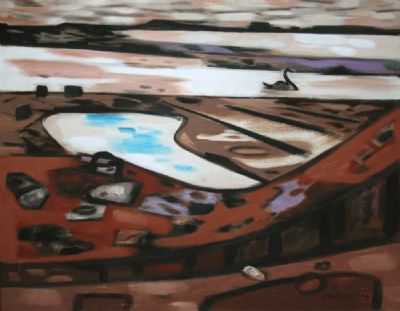Jack Butler Yeats
Lot 39
Jack B. Yeats RHA, 1871-1957 A LAMENT (1930) Oil on canvas, 18'' x 24'' (46cm x 61cm), signed, inscribed verso. Exhibited: 1931 Dublin (6); 1945 Dublin National Loan(74); 1961 Greenwich (3); 1965 Massachusetts (6); 1972 Wisconsin (2) Provenance: So...
Read more
 Lot 39
Jack Butler Yeats
Estimate: €150,000 - €250,000
Result: Not Sold
Lot 39
Jack Butler Yeats
Estimate: €150,000 - €250,000
Result: Not Sold
 Lot 39
Jack Butler Yeats
Lot 39
Jack Butler Yeats
Estimate:
€150,000 - €250,000
Jack B. Yeats RHA, 1871-1957 A LAMENT (1930) Oil on canvas, 18'' x 24'' (46cm x 61cm), signed, inscribed verso. Exhibited: 1931 Dublin (6); 1945 Dublin National Loan(74); 1961 Greenwich (3); 1965 Massachusetts (6); 1972 Wisconsin (2) Provenance: Sold in 1944, through Victor Waddington Galleries, to Mrs. E. O'Malley, later Mrs Helen Hooker Roelofs, Greenwich (Conn.); donated in 1979 to the Irish American Cultural Institute in memory of the late Ernie O'Malley; on long term loan to the Irish Museum of Modern Art, 1990; de Veres Art Auction, 16th April, 2002 (lot 140), where purchased by the present owner and which catalogue entry read: 'The painting was accepted by the Goupil Salon for their autumn exhibition in 1930, but withdrawn by the artist as it was badly hung'- Jack B.Yeats, A Catalogue Raisonne of the Oil Paintings by Hilary Pyle, No 421, page 380, Vol I. A Lament was painted in 1930 and was intended by Jack B. Yeats for exhibition at a group show in the Goupil Galleries, in London. The hanging of the painting displeased him and he withdrew it. He exhibited it the following spring at the Engineers' Hall in Dublin. It was noted favourably by the Dublin Evening Mail art critic who described it as ''a wonderful impression of a Dublin funeral against a background of gaily-covered hoardings''. Helen O'Malley, wife of Ernie O'Malley, bought the painting in 1944 and recorded her notes: ''Proscribed funeral procession of Republican leader Harry Boland. Seventy five thousand citizens stood silent in the rain in defiance of proscription by British Government''. [In fact it was the Free State Government.] Helen O'Malley bought the painting in 1944 for one hundred pounds from Victor Waddington. By that time she and her husband knew Jack Yeats. Her view of the picture and her notes on it may have been informed by the information from both men. Jack Yeats painted his substantive depiction of the event, The Funeral of Harry Boland, in 1922 from sketches taken by himself in Glasnevin Cemetery. All photography was banned and the artist claimed that his was the only visual record of the graveside ceremony. A Lament depicts a funeral passing through the streets of Dublin and is more a ''memory painting''. It is also totally different in style, full of colour and movement, and very much a street scene with the backdrop of posters. The 1931 Engineers' Hall exhibition was widely covered by the press and came at a positive time in the artist's career. The harsh criticism his new impressionist style had attracted in the late 1920's had been replaced by more widespread acceptance. Probably more important was the huge and favourable critical impact, particularly in Britain, of his book, Sligo. Critics did still refer to Jack Yeats wielding ''a wicked brush making the pigment fly wildly this way and that,'' and of his playing ''wildly with his paint'' in contrast with the more sober style of other artists. But the year was a high point in a career that had more than its share of setbacks and disillusionment. One critic referred to the Yeats brothers as ''the older giants'' and said of Jack ''he strides vaguely round Dublin and paints pictures, which are more genuinely modern than those of the youngest graduate from the school of Art, and certainly more interesting.'' The painting was shown in the 1945 National Loan Exhibition. This was the only other occasion on which the picture was exhibited during the artist's lifetime. Ernie O'Malley, who had the painting in the family at the time, wrote the Introduction to the catalogue. He said: ''He has used the funeral or burial as a symbol. The death of a man who has suffered in the national fight has often been one of the few public tributes that a people could give to one whom some of them recognised only in death. A sense of ceremonial, which had seemed to disappear from consciousness, would emerge and an impressive ordered intensity show understanding and devotion. The memory of the dead has changed its meaning when seen as a political artifice, or has become outworn in verbal misuse, but in Jack Yeats's pictures it holds an eternal significance.'' Bruce Arnold March 2002
Sign-up to our auction alert
Signup for personalised Irish art recommendations, invitations to viewings and auctions, articles and more.





